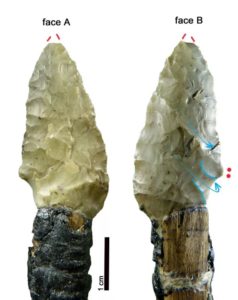Jun 21 2018
Iceman Update
 In 1991 the mummified remains of a 5,300 year old man were found in the Alps on the border of Italy and Austria. The Iceman, also referred to by the nickname, Ötzi (because he was found in the Ötzal mountains) has been the subject of endless study ever since. He represents our best single window into copper-age society.
In 1991 the mummified remains of a 5,300 year old man were found in the Alps on the border of Italy and Austria. The Iceman, also referred to by the nickname, Ötzi (because he was found in the Ötzal mountains) has been the subject of endless study ever since. He represents our best single window into copper-age society.
Scientists continue to learn more and more about Ötzi, what he ate, how he died, what he was doing in the hours before his death, and about the tools he had with him. Recently scientists have published a detailed report looking at the lifecycle of Ötzi’s tools, providing yet more insight.
Before we get to the new info – here is a quick summary of some basic facts about Ötzi. We know that he was shot in the back by an arrow. The arrowhead remains, in fact, in his back as smoking-gun evidence of the cause of death. Amazingly, the presence of the arrowhead was missed on X-rays of Ötzi for years – a great example of inattentional blindness.
Also, he had all his tools with him, including a copper axe and dagger. Copper was a precious material at the time, and these were valuable tools. So, Ötzi was likely not robbed. This means that he may have been murdered. He may have also been shot by accident, confused for an animal, but there is other information to suggest he was murdered.
In the two days prior to his death, Ötzi was up in the mountains. He descended down to a nearby village, probably to get supplies, and there got into some kind of trouble. He acquired a deep cut on his right hand in what appears to be a defensive wound. He then ascended back up into the mountains, where he was shot and killed.
All this suggests that he was in some kind of trouble. He survived an encounter in the village, tried to run away, but his enemies tracked him down and killed him.
This is all a pretty exciting story about someone who lived and died 5,300 years ago.
The new study focuses on Ötzi’s tools. The researchers do a life cycle analysis – where and how were they made, how were they used, and what was their ultimate fate. In this case, we know their fate – their owner was killed and the tools were found on his person.
The full report is an interesting read, but here are some highlights. Ötzi had a copper dagger on him. The point of the dagger was broken off, and so it was likely not very functional. The researchers speculate from this that he wore the dagger on his hip more as a status symbol than as a functional tool.
He has two stone arrowheads on him, but no bow or arrows. We can only speculate why he was carrying arrowhead but no bow or arrow. The researcher suggest he lost his bow in the previous encounter. This is a reasonable hypothesis, but there are countless other possible scenarios. Perhaps he had to sell his bow for needed supplies. Perhaps he found the arrowheads, and kept them for later sale, or for when he was able to obtain a bow for himself.
The researchers also were able to identify the sources of the various stone tools Ötzi had on him. They were from different locations 30-40 miles around the village where he likely lived and operated. This suggests a fairly vibrant economy at the time, with trading happening miles away.
The tools themselves were of moderate quality. If Ötzi made them himself, then he had only moderate skill, and was not a master crafter.
Further, stone tools made from knapping or flaking off bits to make them sharp would quickly dull. They would need to be repaired frequently. Ötzi’s tools were pretty much at the end of their usefulness. They had been repaired over and over, and needed replacing.
This could mean that Ötzi, who hunted or otherwise made his living in the mountains, descended to the village in order to obtain some fresh tools. He then ran into trouble and had to flee before completing his task.
While this speculation is fun, we essentially have no idea what Ötzi was really up to, or all the complex threads of his life. It is possible, however, to weave a plausible tale that is at least compatible with the evidence we have.
More important is the window that Ötzi presents into his time and place. I doubt this study is the last we we hear from Ötzi. He still has some more to teach us.






